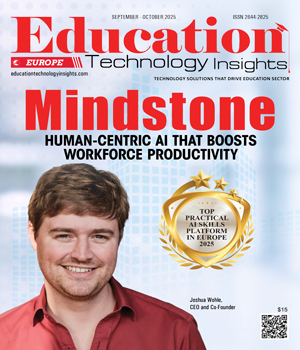THANK YOU FOR SUBSCRIBING
Be first to read the latest tech news, Industry Leader's Insights, and CIO interviews of medium and large enterprises exclusively from Education Technology Insights
From Classroom to Career: How AI is Reshaping Learning and Workforce Development
Dr. Eric A. Canny, Assistant Teaching Professor of Education, the University of Southern California
 Dr. Eric A. Canny, Assistant Teaching Professor of Education, the University of Southern California
Dr. Eric A. Canny, Assistant Teaching Professor of Education, the University of Southern CaliforniaThrough this article, Dr. Eric A. Canny explores how AI drives a fundamental shift in education and workforce development. He highlights the rise of adaptive, personalized learning systems that improve engagement, track progress and align with real-world job needs. The piece underscores AI’s role in restoring trust in learning through relevance and responsiveness.
Artificial intelligence (AI) catalyzes profound, structural change in higher education. It is moving beyond personalized learning to restructure the very architecture of curriculum design, assessment and institutional strategy. But its influence extends far beyond academia—AI transforms how people learn across formal and informal educational settings and within corporate learning and development programs.
My experience as a faculty member and a consultant has shown how AI-powered personalization offers distinct advantages in two interconnected areas: improving the student learning experience and addressing workforce needs. In the classroom, adaptive AI tools provide real-time insights into student progress, new ways of engagement and learning gaps that can be missed by traditional models or were not an option even a year ago.
In corporate training environments, these technologies enable scalable, just-in-time learning pathways that align with job roles, performance metrics and upskilling needs. Whether delivered through microlearning modules or integrated LMS systems, AI-driven training can help employees—and their employers—adapt to the rapidly evolving demands of the modern workplace. We can now use AI to map the requirements for positions in an organization and deliver targeted training and development for those interested in moving to new or more senior roles.
The urgency of this change is underscored by falling public confidence in higher education—only 36 percent of Americans expressed confidence in 2023, down from 57 percent in 2015, according to Gallup. Concurrently, enrollment in traditional four-year programs is either stagnant or declining as interest surges in non-traditional pathways like short-term credentials, boot camps and workforce-aligned certificates.
Post-COVID, the most significant growth, a 30 percent increase in less than 5 years, is seen in stackable credentials, employer-linked microlearning, or learning targeted at the skills needed for a particular job or field. The increase in enrollment in non-traditional forms of higher education.
This landscape demands new marketing and a radical restructuring of learning delivery.
AI-powered personalization is central to this necessary rethink. Corporate leaders increasingly apply these same principles to develop internal learning ecosystems that support skill acquisition, performance monitoring and leadership development.
Adaptive platforms exemplify this by identifying learners—whether students or employees—struggling with content, engagement, or well-being and providing actionable data to instructors, learning designers and administrators. This enables immediate, continuous feedback, surpassing traditional evaluations and allows for real-time instructional and programmatic adjustments that support equity and learner success across sectors.
As a consultant, I encourage institutions and employers to treat curriculum and training design as an ongoing strategic initiative, not an administrative task. AI supports this by aligning learning systems with measurable outcomes— achievement, retention, equity and workforce relevance.
This alignment resonates with today’s outcome-focused learners, especially Gen Z and adult professionals, making it both sound pedagogy and a strategic workforce development and retention tool. As skepticism towards traditional degrees grows, organizations embracing adaptive, personalized models will appear more relevant and future-focused.
Faculty, trainers and learning leaders must play a key role as content experts and strategic partners in this evolution. Corporate and educational organizational leadership must support this shift with investment, cross-sector collaboration and systems that enable data-informed iteration across educational and workforce settings.
AI-powered personalization won’t solve every challenge, but it enables the responsive, learner-centered change this moment demands. It could be a powerful pathway to restoring trust in education and workforce training, not by preserving legacy models, but by designing for the future of learning and work.
Read Also
Building Inclusive Digital Ecosystems Where Students Thrive
The Indispensable Role of Emotional Intelligence in K-12 Technology Leadership
Reimagining Learning in a Digital World
Simplifying Online Program Tuition: Residency-Based Pricing in a Digital Age
Empowering the Future of Online Learning: A Holistic Vision for Transformational Education
Transforming Education Through Technology Leadership

I agree We use cookies on this website to enhance your user experience. By clicking any link on this page you are giving your consent for us to set cookies. More info

However, if you would like to share the information in this article, you may use the link below:
www.educationtechnologyinsightseurope.com/cxoinsights/dr-eric-a-canny-nid-3202.html




















